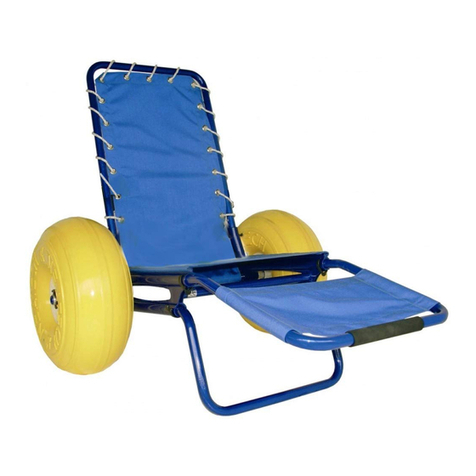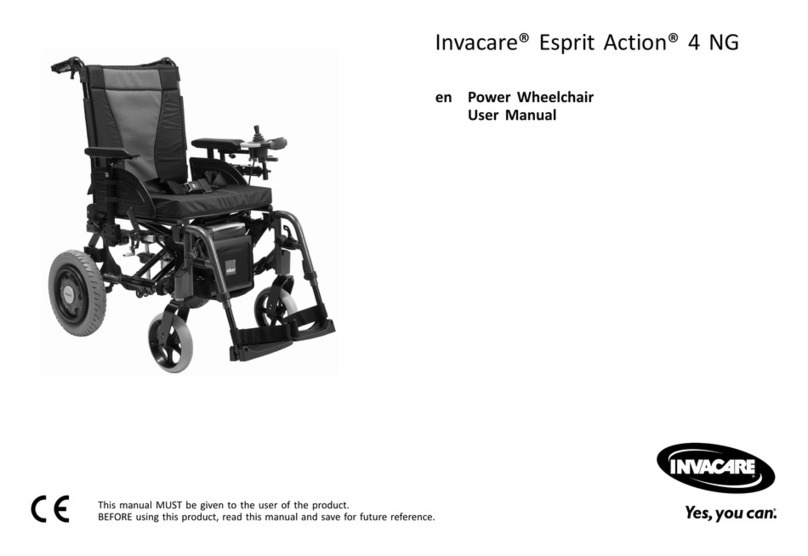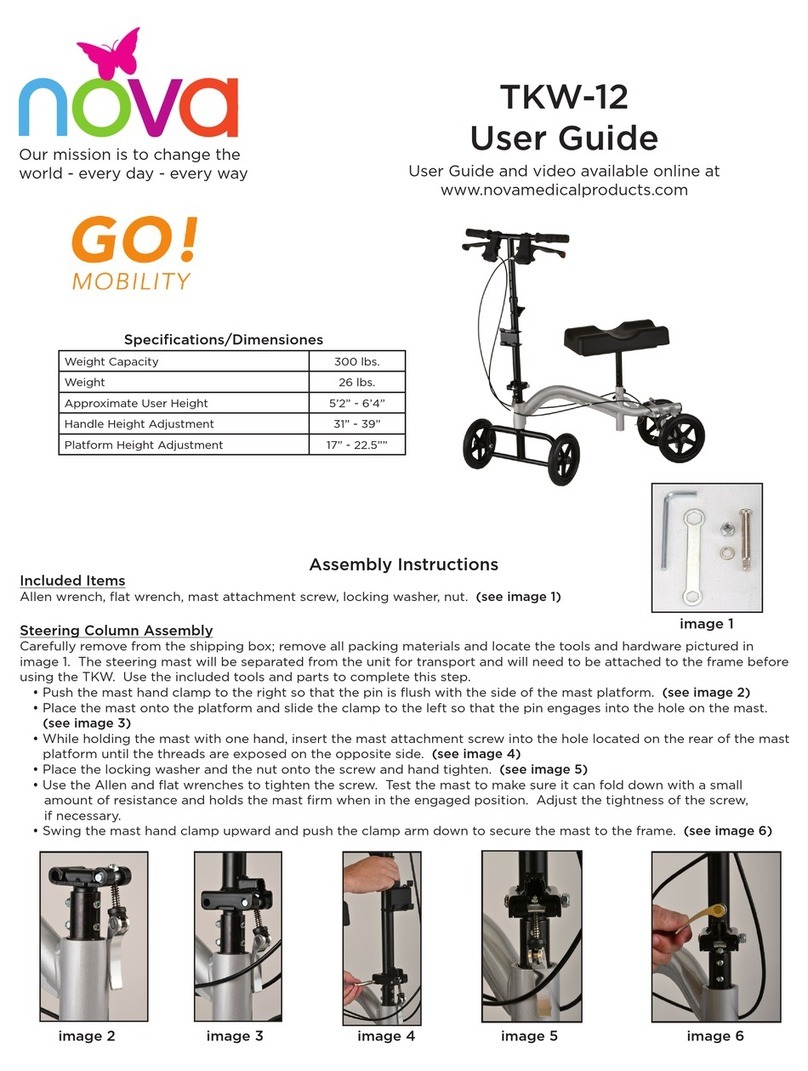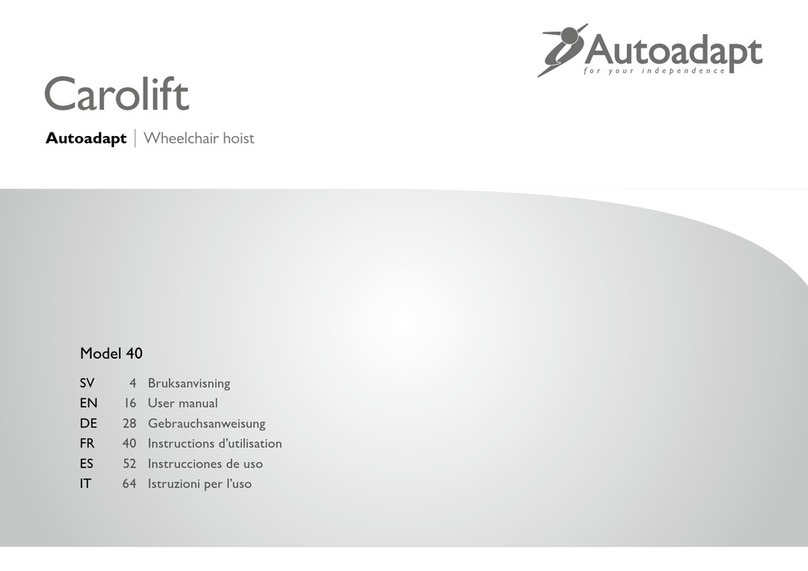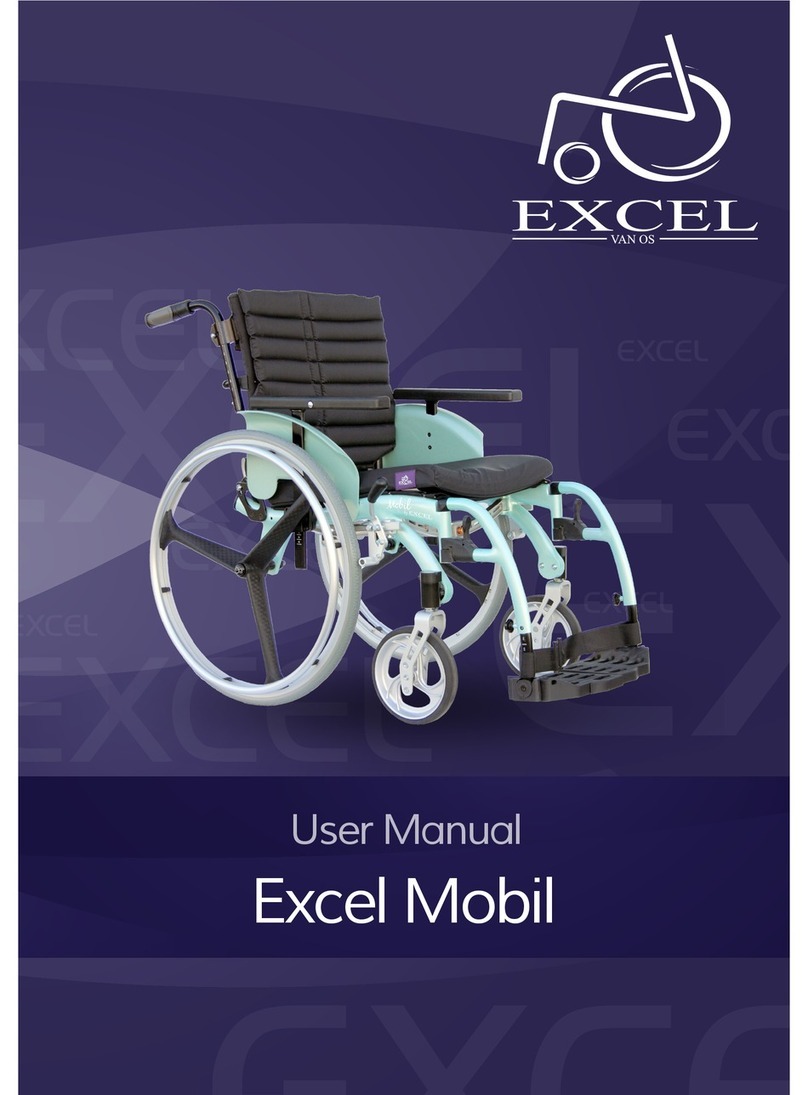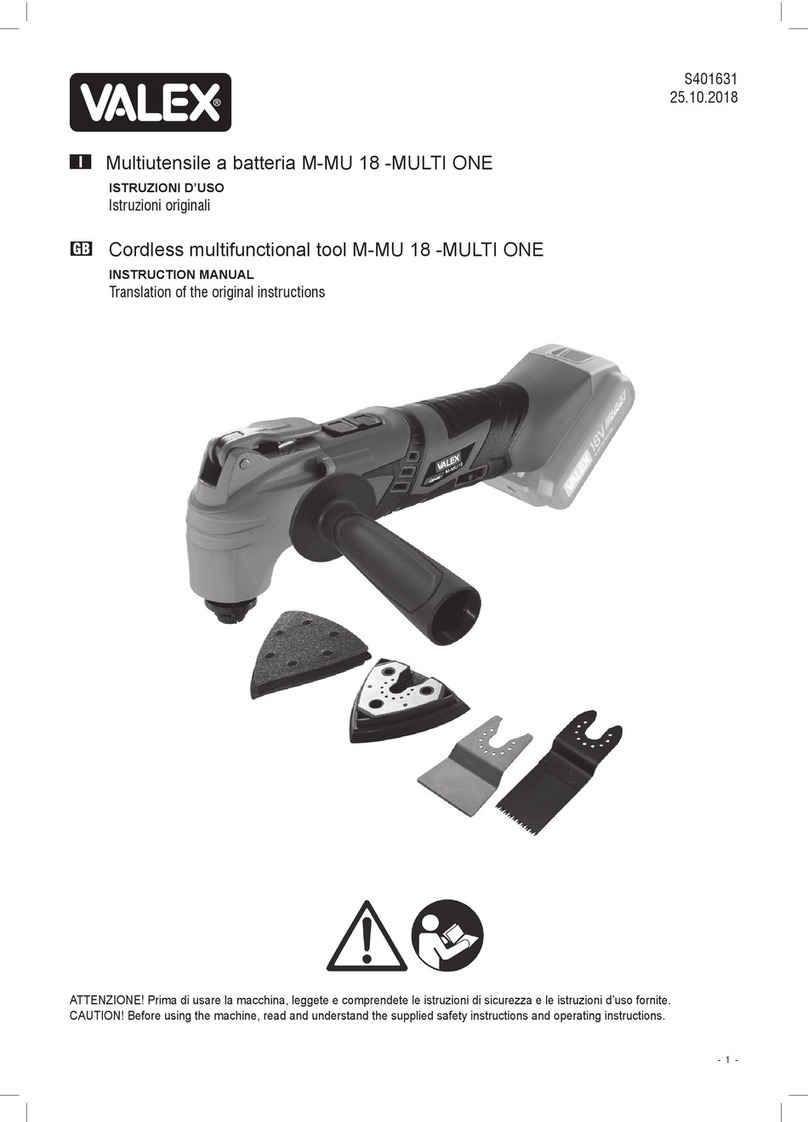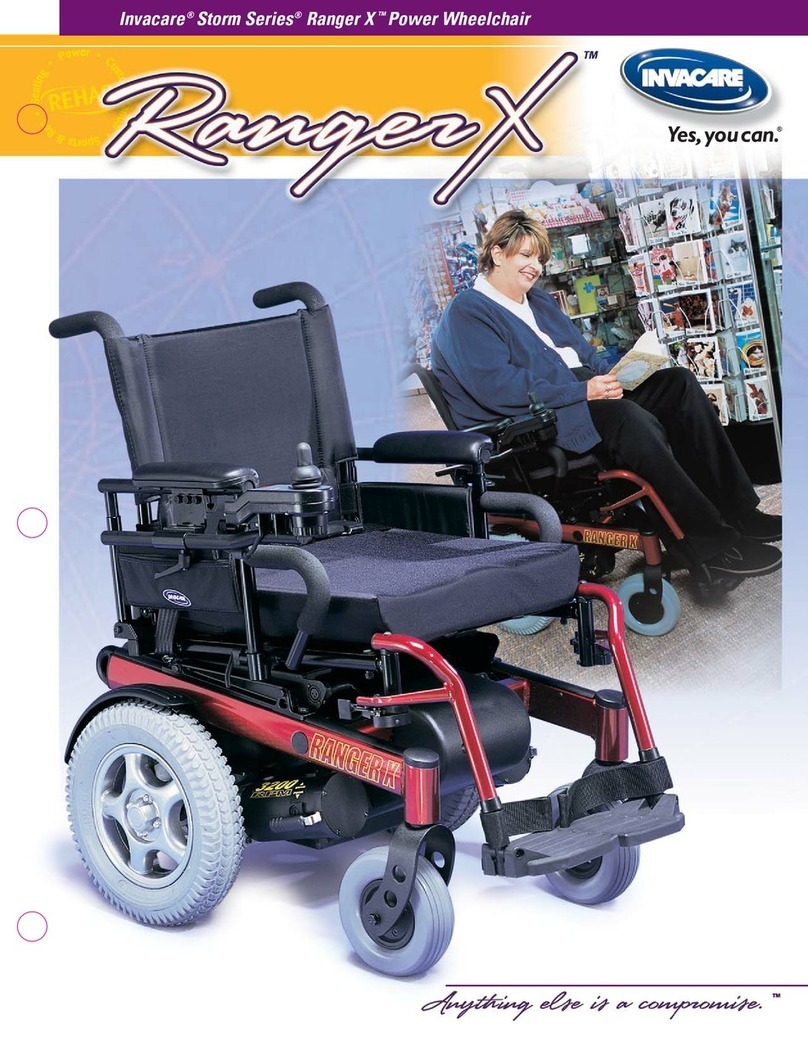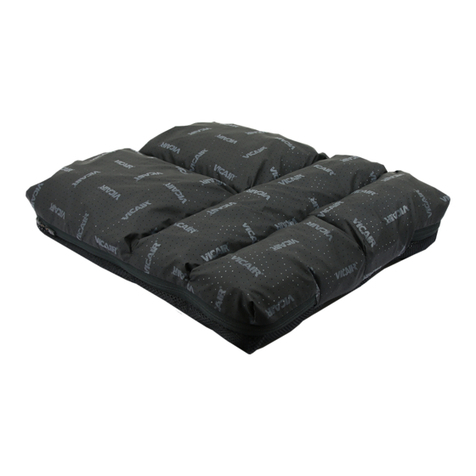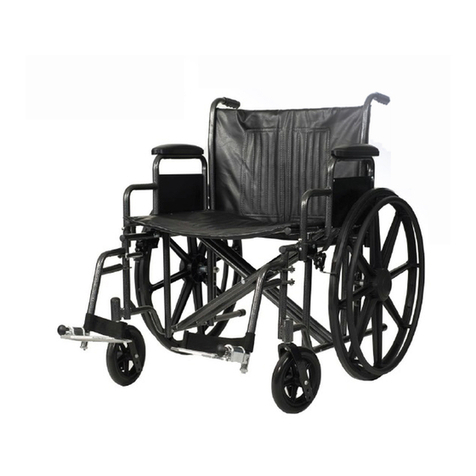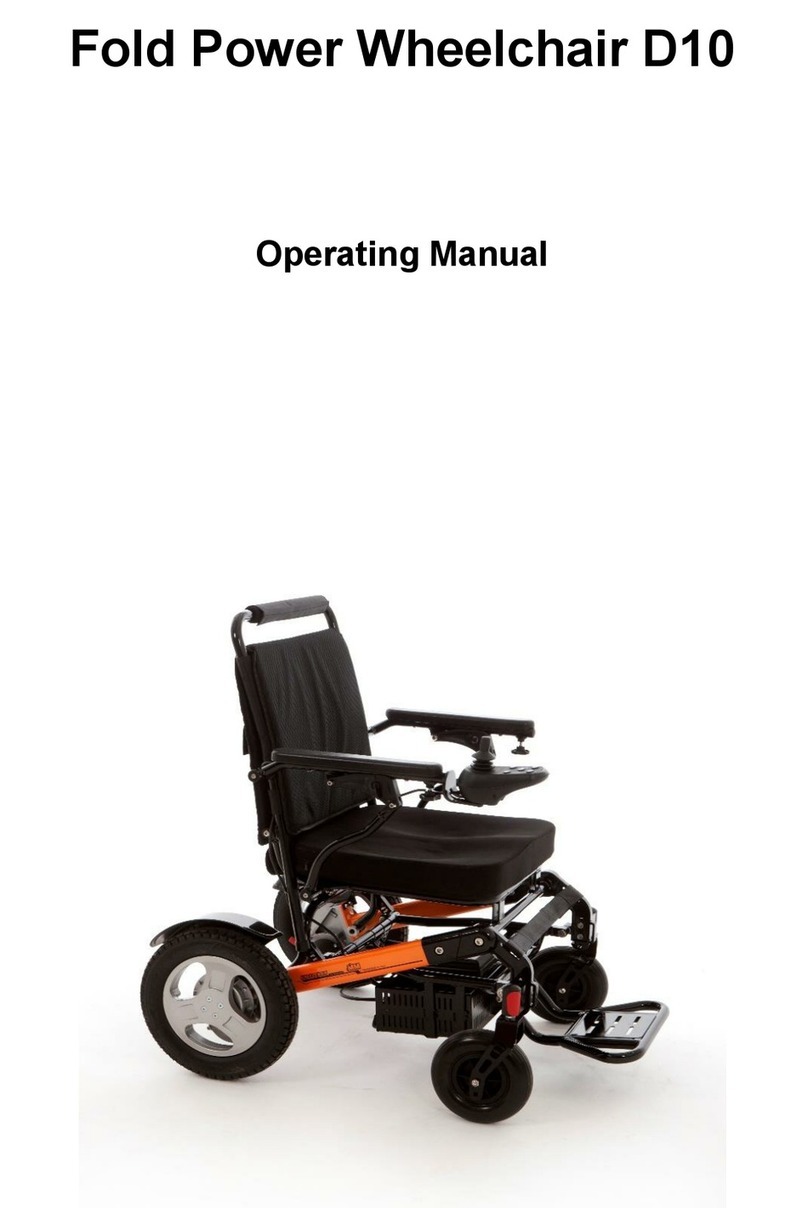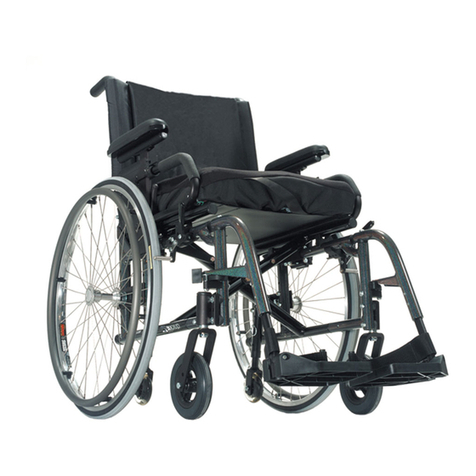Barrett crystal User manual

1
R.J.Mobility
100 Dewsbury Road, Elland. England. HX5 9BG
Tel.no. 01422 324830 Fax.no. 01422 372503
Website - www.rjmobility.com
TECHNICAL MANUAL
Issue 06
May 2013
This Technical Manual will ensure that the wheelchair
is maintained to the required standard and is for use
by trained personnel only
The Proven
Reliable
Indoor/Outdoor
Powerchair
Crystal

2

3
This Technical Manual contains important information regarding maintenance
of the Crystal Powerchair thus ensuring its safe operation. Please make sure that you
understand all instructions thoroughly.
It is recommended that maintenance is undertaken at six monthly intervals for
a wheelchair that is in constant daily use.
The safety of the wheelchair user is paramount. If there is any doubt as to the
suitability of re-using existing parts they should be discarded and replaced with
manufacturer approved parts.
User Manuals should be stamped at correct intervals following completion of
maintenance work.
If you fail to understand anything or have any questions concerning mainte-
nance and operating instructions please contact:
RJ MOBILITY.
100 Dewsbury Road
Elland, HX5 9BG
England
Tel: +44(0) 1422 324830
Fax: +44(0) 1422 372503
Trading division of Boxford Limited, Registered No. 01699383 England and Wales
Registered office as above.

4
Contents
SECTION
1 User Categories
2 Specifications
3 Powerchair Diagram
4 Maintenance Checks
5 Tool Requirements
6 Upholstery
7 Armrests
8 Footrests
9 Brakes
10 Push Handles
11 Frame, Locking Links And Cross Braces 12
Castors
13 Power Drive System
14 Electrical System
15a Programmable Controller (P&G Pilot) 15a
Programmable Controller (Dynamic DL) 16
Elevating Legrest
17 Armrest Outriggers
18 Detachable Tray
19 Transportation.

5
SECTION 1: User Categories
A2 Attendant Controlled. Degree of upper body control to maintain sitting position.
A4 Occupant capable of using one hand to control the powerchair having spatial
awareness, co-ordinated motor skills and sufficient manual dexterity to operate the control-
ler. The occupant should also have enough upper body control to maintain a sitting position.
A5 Chin Controlled. Degree of upper body control to maintain sitting position. Capable of using
chin movements to control powerchair. Co-ordinated motor skills.
IMPORTANT
The above identifies the minimum user
characteristics suitable for the Crystal
foldaway powerchair.

6
SECTION 2: Specifications
(Dimensions based on seat size 43cm x 43cm (17inch x 17inch)
1 Overall length 100cm (39.5 inch)
2. Overall width Nominal width+17.5cm (7 inch)
3. Folded length 78cm (31 inch)
4. Folded width 55cm (21.5 inch)
5. Folded height 55cm (21.5 inch)
6. Complete weight 70kg (154 lbs)
7. Heaviest Component 36kg (79 lbs)
8. Seat plane angle 5.5º (to ground)
9. *Seat depths available 43cm (17 inch)
10. *Seat widths available 35.5cm (14 inch)
38cm (15 inch)
40.5cm (16 inch) 43cm
(17 inch)
45.5cm (18 inch)
11. Seat height at front 49cm (191/2 inch)
12. Backrest angle 90º (Std)
100º (Optional)
13. *Backrest height (above seat) 44cm (17.5 inch)
14. Footrest to seat 30-41cm (12-16 inch)
15. Leg rest angle 85º (from horizontal)
16. Armrest to seat 23cm (9 inch)
17. Front armrest to backrest 42cm (17 inch)
18. Drive wheel diameter 315mm (12.5 inch)
(Tyre size 12.5 x 2.25)
19. Tyre pressures (Rear) 50psi/340 kilopascals (KPA)
(if pneumatic option fitted)
20. Maximum load capacity 114kg (18 stone/252 lbs)
21. Turning Space
(a) Spin turn 205cm (6ft 7 inch)
(b) 3 point turn 133cm (4ft 4 inch) (c) 28inch
doorway turn 100cm (3ft 3 inch)
22. Range **(40 Amp/hr Battery) 17.8km (11 mile)
23. Static stability
(a) Front 30º (b) Rear
30º (c) Side 20º
24. Maximum forward speed 2.2 kph (1.4 mph)(25A)
5.5 kph (3.4 mph)(40A)
25. Maximum stopping distance 1.5m (5ft)
26. Dynamic stability uphill 20º
* Note: Please be aware, other sizes may be available to special request.
** Note: The range test was conducted in accordance with ISO 7176 Pt 4, capacity is affected
by ambient temperature, user weight, topography, kerb climbing and battery maintenance.

7
SECTION 3: Wheelchair Diagram
3.1 Crystal Self-Propelling Powerchair
1-POWERCHAIR
FOLDED
2-BATTERY WITH
CIRCUIT BREAKER
3-ARMREST
4-FOOTREST HANGER
WITH FOOTPLATE
5-BATTERY TRAY
6-BATTERY STRAP
7-BATTERY TRAY
RESTRAINT BAR
4-FOOTREST HANGER
WITH FOOTPLATE
8-CONTROLLER
2-BATTERY WITH
CIRCUIT BREAKER

8
SECTION 4: Maintenance Checks
4.1 Open the powerchair, all movements should be free throughout the folding range.
4.1.1 Examine the seat and backrest fabrics for wear, damage or staining.
Examine retaining screws for tightness and general condition. (See Section 6)
4.1.2 Examine armrest pads for wear or damage and tightness of attachment screws.
(See Section 7)
4.1.3 Examine armrest locking assembly for wear and tear and that each armrest is securely
retained. (See Section 7)
4.1.4 Examine footrest hanger for effective locking when fully forward and back. Examine clamp
assembly for secure location of footplate assembly stem tube. Check that footplates
remain vertical when raised. Examine heel loops for damage or excessive wear and
security of attachment. (See Section 8)
4.1.5 Examine the parking brake assemblies for wear, damage or misalignment. (See Section
9)
4.1.6 Check operation of folding push handle assembly and that it is free to move and locks into
place positively. (See Section 10)
Check that the hand grips are not damaged and are securely fitted to the push handle.
4.1.7. Ensure that tube plugs and ends are fitted to:
Front of seat tubes.
Front of bottom frame tubes.
Armrests front and rear.
Top of backrest tubes.
4.2 Lift the front of the powerchair and rest the push handles on the floor.
4.2.1 Examine the structure of the frame for damage.
4.2.2 Check the pivot points for undue slackness, caused by loose nuts and bolts, or worn parts.
Check that front and rear locking links fully lock. (See Section 11)
4.2.3 Check castors for free rotation of the wheel and the complete assembly. Examine castors
for wear in the bearings. Examine locating spindle for signs of bending, at the point where
it is attached to the frame. (See Section 12)
4.2.4 Examine tyres for uneven wear. Check wheels for free rotation, excessive end float and
rim rock.
4.2.5 Check controller is secure to mounting bracket and that this can be secured to powerchair
by knurled knob/handle on armrest. Examine controller for damage, particularly any which
may allow ingress of fluid. Check joystick knob is secure to controller, speed control knob
and charging socket cover are in place. Move joystick around quadrant checking for any
roughness or stickiness, on release the joystick must self-centre immediately otherwise
braking of the powerchair will be compromised. Ensure that all LED's are functional so that
it can be determined when controller is switched on/off and that any diagnostic information
is accurate. Check that beau plug on wiring loom fits securely.
4.2.6 The batteries fitted are leak-proof and require no maintenance except to check for damage
and security of connections. See Section 14.6 for comprehensive instruction.
4.2.7 The battery charger is maintenance free, the only serviceable part is the fuse fitted to the
mains plug. See Section 14.6 for comprehensive instruction.
4.2.8 Ensure the batteries are fully charged.
4.2.9 Drive the Crystal at maximum speed in forward, reverse, left and right directions checking
that the joystick response is uniform.

9
4.2.10 Switch off the controller, hold the joystick forward and switch the controller on; the
powerchair must not drive. Release the joystick for two seconds and then the powerchair
will drive normally.
4.2.11 Slowly drive the powerchair up a maximum 1 in 6 gradient and attempt to accelerate. The
powerchair will climb at normal speed.
4.2.12 Reverse down a 1 in 6 slope and check that the powerchair will come to a halt if the joystick
is released.
4.2.13 Whilst driving slowly up the gradient release the joystick and check that the powerchair
does not roll back excessively before the automatic parking brakes come on.
4.2.14 Check that all cables are connected to the controller, batteries, motors and brakes.
4.2.15 Check that the circuit breaker push buttons on the battery boxes have not sprung out.
4.2.16 Check that the free wheel devices are releasing and engaging correctly.
4.3. Check that controller rubber gaiter and switch cover are in good condition.
4.3.1 Check the insulation condition of all cables.
4.3.2 Check that the controller is securely mounted.
IMPORTANT
This chair must only be used with the push handles upright and
locked in position.
Both armrests must be be securely located at the sides of the
seat and be engaged with the push handles.

10
SECTION 5: Tool Requirements
Spanners:
1/4inch Whitworth Legrest Clamp See Section 8 10mm AF
Heel Loops See Section 8
8mm AF Parking Brake See Section 9
1/4inch Whitworth Anti-tip Device See Section 11
1 5/16inch or 34mm AF Castors See Section 12
1 5/16inch or 34mm AF Power Drive System See Section 13 10mm Socket
and Driver Power Drive System See Section 13 7/16inch AF
General
Allen Keys:
4mm Locking Link See Section 11
Pozidrive Screwdriver Upholstery See Section 6 Avdel Nutsert
Rivet Tool Upholstery See Section 6 Loctite Thread Locking
Castors & Wheels See Section 12/13
Compound Grade 241
Terminal Crimp Tool Power Drive System See Section 13
to suit 0.5mm to 6.0mm crimps
Torque Wrench:
Minimum Operating Range
8 lbs/ft (11 Nm) General
Small Pliers General Light/Soft
Head Hammer General Light Oil, e.g. 3 in 1
General Wire
cutter General Power Drill
and 6mm Bit General 1/4inch Receptacle
wire crimp tool General Snap Rivet tool
General
P&G PP1b programmer & diagnostics device See Section 15a
Control Dynamics programmer & diagnostics device See Section 15b
Advised:
Watt/Minute meter (Current Draw)

11
SECTION 6: Upholstery
6.1 Diagram
6.2 Parts List
RJ Part No
Seat Fabric Ninian 14 x 17 inch 35.5cm x 43cm SF61-14-17
Ninian 15 x 17 inch 38cm x 43cm SF61-15-17
Ninian 16 x 17 inch 40.5cm x 43cm SF63-16-17
Ninian 17 x 17 inch 43cm x 43cm SF63-17-17
Ninian 18 x 17 inch 45.5cm x 43cm SF63-18-17
Backrest Fabric Ninian 14 x 17 inch 35.5cm x 43cm SF62-14-17
Ninian 15 x 17 inch 38cm x 43cm SF62-15-17
Ninian 16 x 17 inch 40.5cm x 43cm SF64-16-17
Ninian 17 x 17 inch 43cm x 43cm SF64-17-17
Ninian 18 x 17 inch 45.5cm x 43cm SF64-18-17
M5 x 20 long, raised countersunk screw F102 No. 8
flanged screw cup F101 M5
Avdel UNF Nutsert 09657/01014
Reinforcing Bars Seat and Backrest SF176

12
6.3 Inspection
Fabric:
Check for staining, wear, tear and stitching.
Check nut inserts in frame for security and stripped threads.
Check securing screws for bending and stripped threads and burrs.
Cushions (if fitted);
Check cushions for staining, wear, tear and stitching.
Check Velcro attachment tabs are present and secure.
6.4 Fabric Removal
If the Nutserts need replacement, use Avdel recommended tooling.
6.5 Fabric Fitting
Slide reinforcing bar into stitched section on each side of the seat fabric only.
Fit countersunk screws through flanged cups and fit through holes in fabric and reinforcing bars.
Place fabric on seat and backrest tubes and tighten screws taking care not to exert excessive
force to flatten the flange cup or cut into the fabric.

13
SECTION 7: Armrests
7.1.1 Diagram (Non-Domestic)
ARMREST ASSEMBLY SP*** L/H
SP*** R/H
7.1.2 Parts List (Non-Domestic)
RJ Part No
Armrest Assembly complete - Left XXSP2018L/9L-L
- Right XXSP2018L/9L-R
Armrest Pad Black M170
No. 12 x 1 1/4 Pozipan AB
self tapping screw zinc plated F111
Armrest Panel - Left SF232L
- Right SF232R
AVEX 1/8" pop rivet (not shown) F46
Armrest frame - Left SF-604L
- Right SF-604R
Tube plug M7/2440
ARMREST PAD M-170
BUNG M7/2440
ARMREST FRAME SF-604L
SF-604R
PANEL SF-232L
SF-232R
No12x11/4” POZIpan AB SCREW

14
7.3 Inspection
Check armpad for excess wear or damage.
Check armpad is secured to frame.
Check side panel is not damaged.
Ensure armrest locates in rear bracket on push handle when fitted to wheelchair.
7.4 Armrest Pad
The armrest pad is secured to the armrest frame with three screws whilst the domestic
armrest pad is secured to the armrest frame with two screws. Removal of the screws releases the
pad. Secure the pad with the attachment screws to refit.
7.5 Armrest Panel
The plastic panel is removed by carefully drilling off the heads of the two pop rivets using
a 1/4" (or equivalent) drill bit. Slide the panel forwards on the armrest frame until the moulded
hooks release from the tube.
The plastic panel is fitted by placing the moulded hooks against the armrest frame tubes
and pushing the panel backwards on the frame. Fit 2 new pop rivets using the correct tool.

15
SECTION 8: Footrest
HANGER ASSEMBLY SP406 L/H
407 R/H
8.2 Parts List
RJ Part No
Footrest Hanger with retaining - Right SP406 clamp
assembly M102 - Left SP407
Retaining Clamp Assembly M102
5/16 x 1 1/4 Inch Bolt, zinc plated F20
5/16 inch Locking Nut, zinc plated F21
5/16 inch Washer, zinc plated F22 Footplate
Assembly 8 1/2 inch, complete with
Stem and Heel Loop - Left SP306L
- Right SP306R
Footplate Assembly 7 1/2 inch, complete with
Stem and Heel Loop - Left SP211L
- Right SP211R
Footplate Spring TSD1349
Heel Loop complete with nuts and washers TSD 114 69/2
No. 4 x 1/4 Pozipan Type Self Tapping
Screw, zinc plated 0456A M6 x 30 Hex Hd Screw
F125 M6 Plain Nut F222

16
8.3 Inspection
Check that footrest assembly locks into position.
Apply light grease to swiveling end.
Ensure that stem clamp holds footplate in position.
Ensure that footplate will remain in vertical position when required.
Ensure that there are no sharp edges/burrs which could injure user.
8.4 Footrest Removal
Remove the footrest assembly from the powerchair by lifting and rotating the hanger
section. Loosen the clamp with a 1/4inch Whitworth spanner and slide the stem assembly out.
8.5 Footrest Fitting
Re-assemble heel loop to footplate and tighten nuts to 10 lbs/ft (13.5Nm). Insert footplate
stem into hanger tube and tighten clamp to 35 lbs/ft (47Nm).
The footplate should remain in the vertical position when required. This is maintained by
semi-elliptic spring acting between the footplate and the pivot tube. This does not normally require
maintenance.

17
SECTION 9: Brakes
9.2 Parts List
RJ Part No
Brake LH M-256L
Brake RH M-256R
9.3 Inspection
Check levers for distortion.
Check pivot shafts for distortion.
9.6 Brake Adjustment
The Brake Bar position can be adjusted by loosening the two socket set screws and
repositioning the bar. Adjust to allow an operating force at the handle to be between 10lbf to 13lbf
(44 to 58 N) with the tyres inflated to the correct pressure (50psi/340 KiloPascals).

18
SECTION 10: PUSH HANDLES
10.1 Diagram
PUSH HANDLE ASSEMBLY SP-404 L/H & SP-405 R/H (BARRETT STYLE)
SP-404-8L/9L L/H & SP-405-8L/9L R/H (90°8L/9L STYLE)
10.2 Parts List
RJ Part No
Push Handle Assy complete (Barrett style) L/H SP-404
R/H SP-405
Push Handle Assy complete (8L/9L style) L/H SP-404-8L/9L
R/H SP-405-8L/9L
Push Handle LH (Barrett style) SF-160L
Push Handle RH (Barrett style) SF-160R Push
Handle LH (90° 8L/9L style) SF-577L
Push Handle RH (90° 8L/9L style) SF-577R 1/4”UNFx3/4”hex
head bolt zinc plated hex head bolt zinc plated F10
1/4” UNF self locking thin nut zinc plated, F-P90
Hand grip M57

19
10.3 Inspection
Check each push handle for evidence of bending.
Check each push handle for evidence of cracking through nutsert holes.
Check handgrip is secure.
Check for free movement of plunger. Lubricate with light oil.
Check that plunger locates in the hole at rear of the side frame.
Ensure nyloc nut still grips thread.
10.4 Push Handle Removal
Unscrew 4 off M5x20 countersunk screws holding the seatback upholstery to the Push
Handle Assembly.
Unscrew 1/4” UNF nut and withdraw the bolt.
10.5 Push Handle Fitting
Insert 1/4 UNF bolt through Push Handle and hinge bush. Tighten the nyloc nut until Push
Handle pivots freely without excessive free-play.
Fit 4 off M5x20 countersunk screws to hold the seat back upholstery to the Push Handle
Assembly.
Wrap the 50mm wide Velcro strap around the lower end of the Push Handle and secure to
the rear.

20
SECTION 11: CROSSBRACE ASSEMBLY
11.1 Diagram
CROSS BRACE ASSEMBLY SP205
There are two Cross Brace Assemblies in this wheelchair which have identical parts.
11.2 Parts List
RJ Part No
Cross Brace Assembly 14" complete with fasteners SP-206-14
Cross Brace Assembly 15" complete with fasteners SP-206-15
Cross Brace Assembly 16" complete with fasteners SP-205-16
Cross Brace Assembly 17" complete with fasteners SP-205-17
Cross Brace Assembly 18" complete with fasteners SP-205-18
M6 x 35 long, HT hexagon head bolt, zinc plated F126
M6 self-locking nut, zinc plated P80
1/4 Diameter Nylon plain washer F86
M6 x 25 HT hexagon head set screw, zinc plated F124
Nylon spacer F65.
Table of contents
Other Barrett Wheelchair manuals


